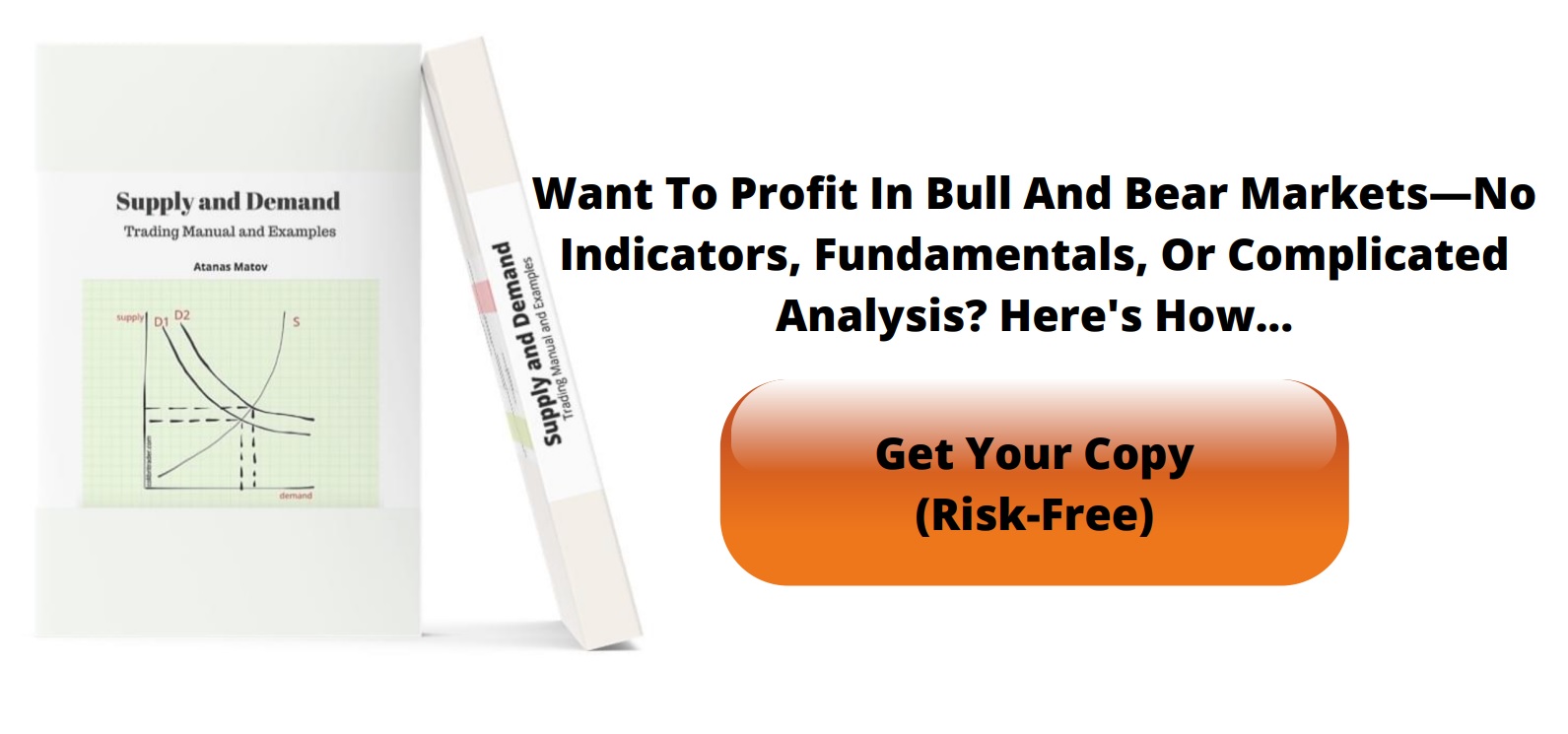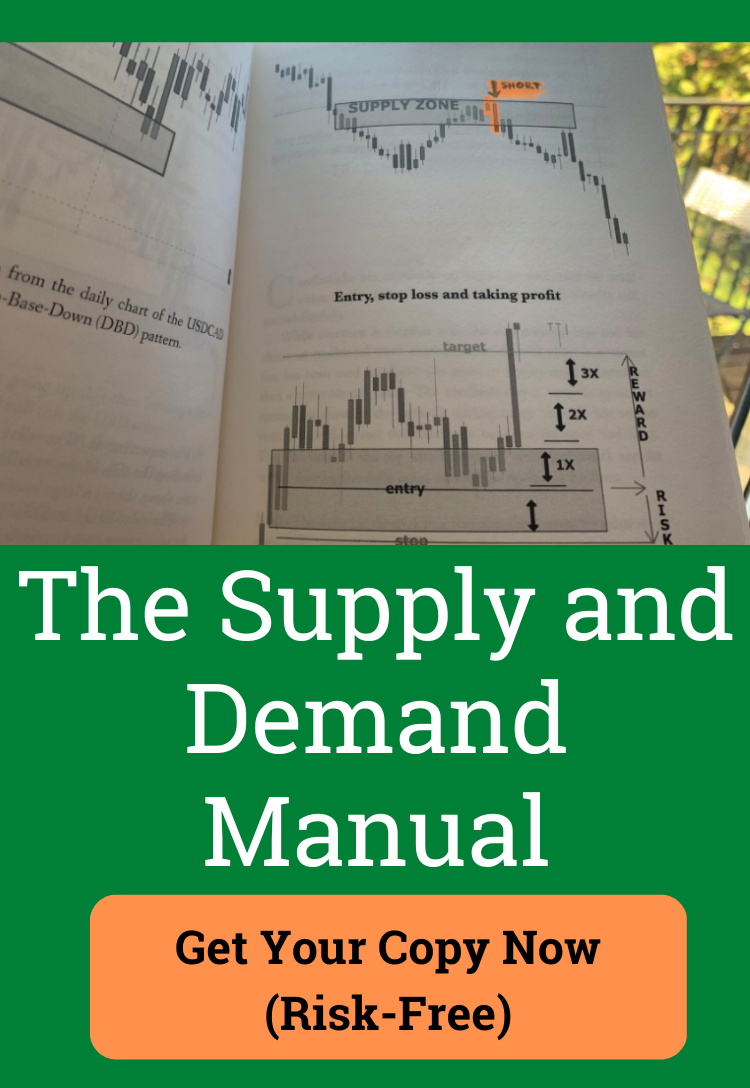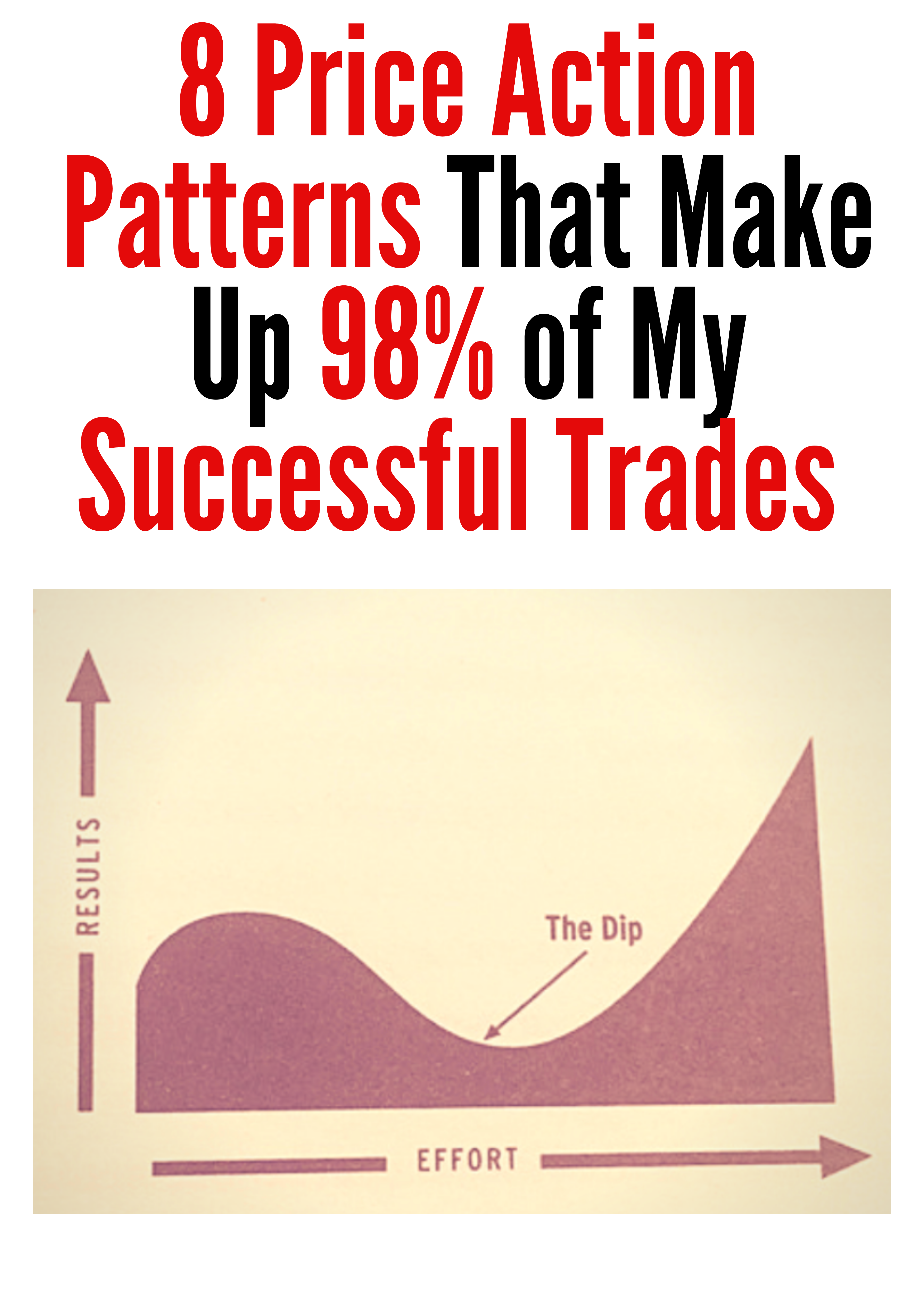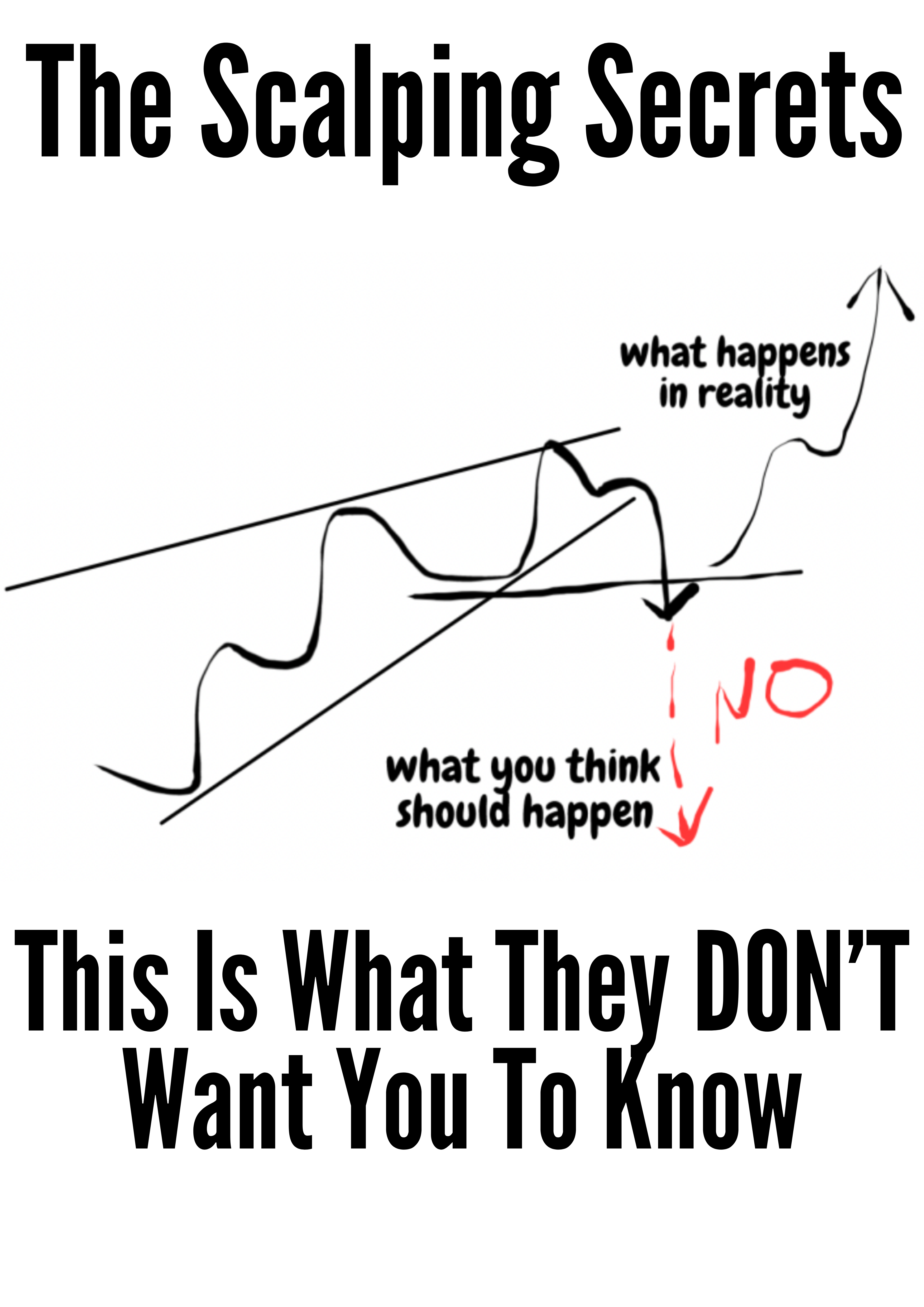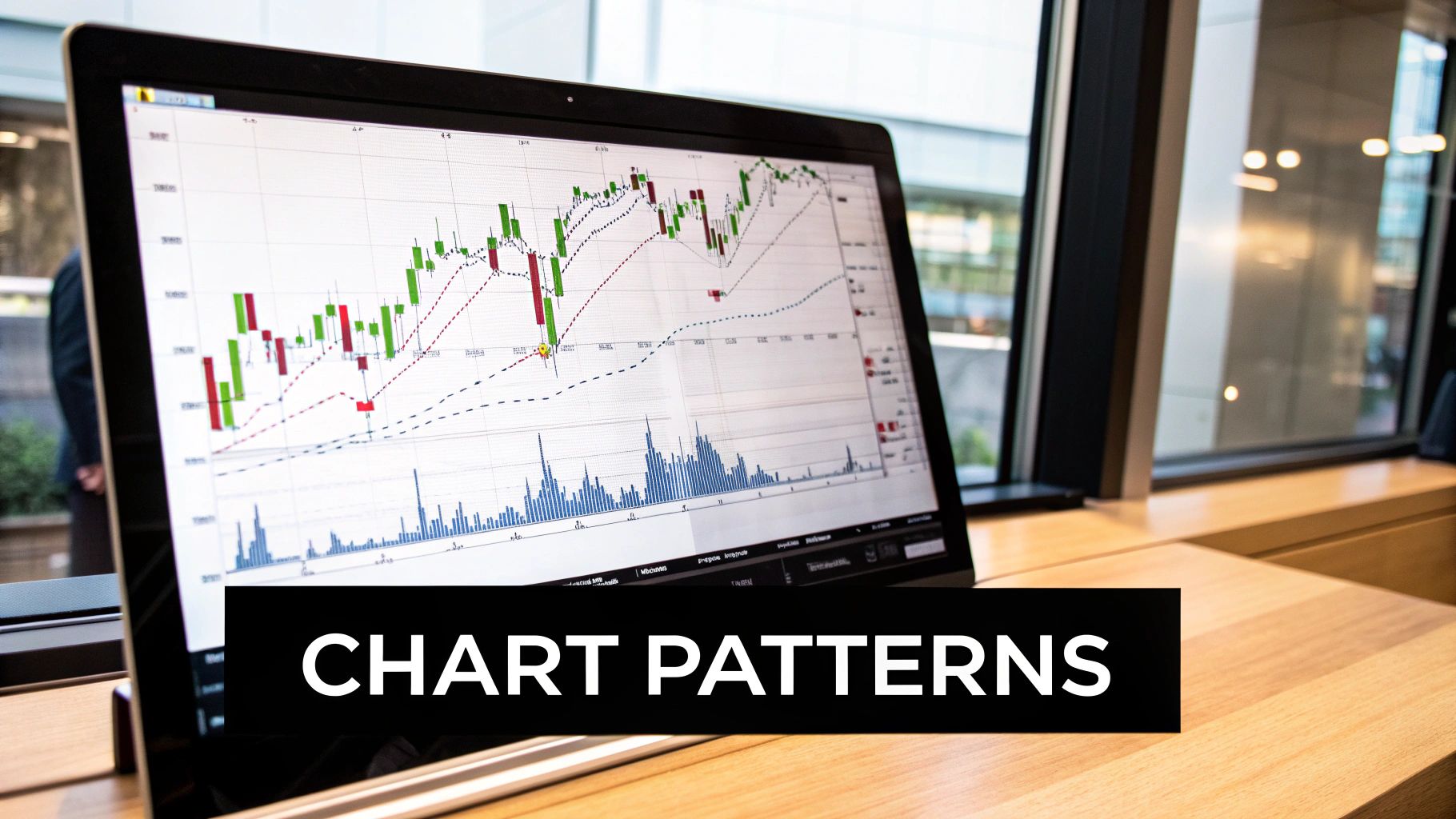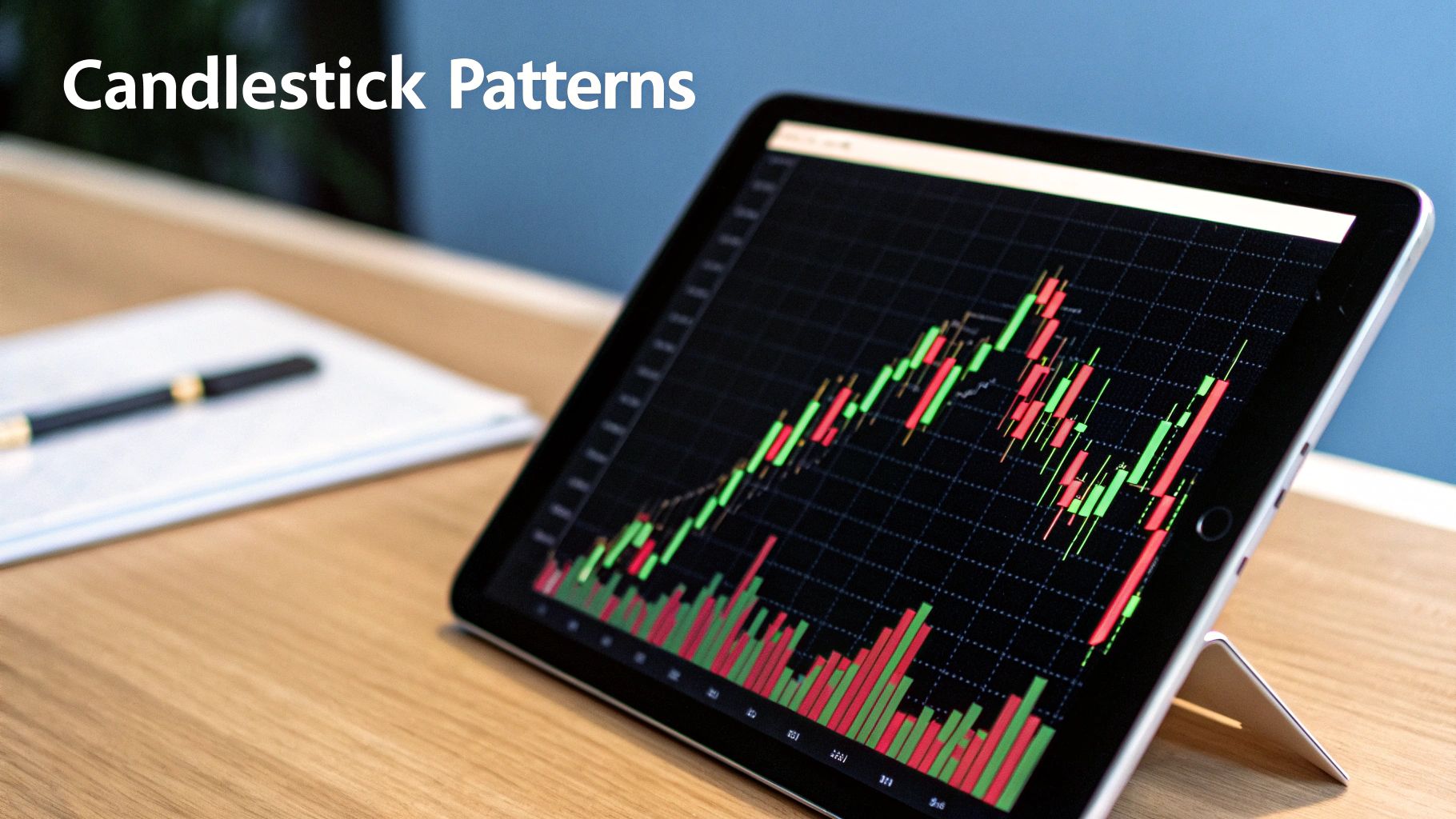6 Best Books on Price Action Trading: Master the Markets
Unlocking Market Secrets with Price Action
Want to decipher market movements and make smarter trades? This list of the 6 best books on price action offers practical strategies for all skill levels, from novice to professional. Learn how to interpret support, resistance, and chart patterns to anticipate market direction and improve your trading performance. Whether you're new to price action or seeking to refine your existing approach, these resources provide invaluable insights into proven, action-based techniques. Several of these books echo the practical approach of institutions like Colibri Trader, emphasizing real-world application.
1. Price Action Trading Secrets by Rayner Teo
If you're searching for the best books on price action, Rayner Teo's Price Action Trading Secrets deserves a top spot. This comprehensive guide breaks down the complexities of price action trading into easily digestible information, making it an excellent resource for traders of all levels, from beginners to seasoned professionals. Instead of relying heavily on indicators, Teo presents a systematic approach to analyzing market movements based purely on price dynamics, empowering you to read the raw language of the market. The book covers essential price action patterns, market structure analysis, and practical trading strategies applicable across various timeframes and markets like forex, stocks, and cryptocurrencies.
This book stands out for its clear and accessible language, making even complex concepts understandable for novice traders. Rather than just presenting theoretical concepts, Teo focuses on providing actionable trading strategies that readers can implement immediately. He also delves into the psychological aspects of trading, a crucial element often overlooked in technical analysis books. Drawing upon his own real-world trading experience, Teo shares valuable lessons and insights he's learned throughout his career.
The infographic below visualizes key data about the effectiveness of price action trading as taught in the book, based on backtested results and user surveys.
As the infographic reveals, a significant percentage of traders who implemented the strategies from the book reported improved win rates and reduced losses. The data emphasizes the potential of price action as a standalone trading method, capable of generating consistent returns across different market conditions. The visualized statistics highlight the impact of disciplined risk management and consistent application of the strategies taught in the book. For instance, the infographic likely shows a correlation between consistent practice and improved trading performance, showcasing the importance of dedication and learning.
Price Action Trading Secrets benefits traders seeking foundational price action techniques, those struggling with inconsistent strategies, and even experienced traders looking to refine their skills in areas like supply and demand. The book equips you with the knowledge and tools to identify high-probability trading setups, manage risk effectively, and navigate the psychological challenges of trading. The step-by-step methodologies and visual examples of chart patterns and setups facilitate practical application and accelerate the learning process.
While the book caters to a broad audience, some advanced traders might find certain concepts oversimplified. The book could also benefit from more statistical validation of the patterns presented and broader coverage of specialized price action techniques.
Examples and Tips:
The book is filled with numerous chart examples from various markets, including forex, stocks, and cryptocurrencies. It also features case studies demonstrating how price action can predict significant market reversals and how Teo himself used these techniques in successful trades.
To maximize your learning, Teo recommends focusing on mastering one pattern at a time, practicing identification on historical charts before live trading, combining price action with market context, and starting with higher timeframes before moving to shorter ones.
Why this book deserves its place on the list:
Price Action Trading Secrets excels in providing a clear, actionable framework for price action trading, making it invaluable for traders of all levels. The book's focus on practical application, combined with the author's real-world experience, makes it a powerful tool for achieving consistent profitability in the markets. While not exhaustive in its coverage of every nuance of price action, it provides a solid foundation that can be further built upon. Though no website link is directly provided for the book itself, Rayner Teo's trading resources and further information can be found on his website, TradingwithRayner, and his YouTube channel.
2. Encyclopedia of Chart Patterns by Thomas N. Bulkowski
For those seeking a data-driven approach to price action, the Encyclopedia of Chart Patterns by Thomas N. Bulkowski is a must-have. This book goes beyond simply identifying chart patterns; it dives deep into their statistical performance, providing traders with an evidence-based framework for making informed decisions. Bulkowski meticulously analyzes nearly 70 price action patterns, leveraging extensive research based on thousands of historical market scenarios. He doesn't just tell you what a pattern looks like; he tells you how it performs, outlining its success rate, failure rate, and average profit potential. This makes it an invaluable resource for traders looking to understand the probabilities associated with specific patterns and integrate this knowledge into their trading strategies. This approach moves beyond theoretical concepts and empowers traders with concrete data to back up their trading decisions, making it a top choice among the best books on price action.
This book's strength lies in its statistical approach. Bulkowski ranks patterns based on their historical performance, providing a clear hierarchy of reliability. He offers detailed identification guidelines for each pattern, ensuring traders can accurately spot them in real-time. Moreover, he outlines specific entry and exit strategies for each formation, helping traders optimize their profit potential while managing risk. The book also delves into pattern failure analysis, highlighting warning signs that can help traders avoid costly mistakes. This comprehensive approach to price action analysis makes it an invaluable asset for traders of all levels.
Examples of Successful Implementation: The Encyclopedia provides statistical analysis of thousands of actual stock market patterns, showcasing real-world examples of how these patterns play out. Bulkowski includes case studies demonstrating both successful and failed pattern completions, offering valuable learning opportunities. He also shows how pattern performance varies across different market conditions, emphasizing the importance of contextual analysis.
Actionable Tips for Readers:
- Prioritize Reliable Patterns: Use the performance ranking tables to focus your efforts on the most statistically reliable patterns.
- Confirm with Volume: Pay close attention to volume characteristics that accompany patterns for added confirmation.
- Consider Market Context: Always consider the broader market context and trend direction when evaluating pattern probability.
- Use Checklists: Utilize the identification guidelines as checklists when scanning for potential setups.
When and Why to Use This Approach: This book is beneficial for traders at various stages of their journey. Novice traders can gain a foundational understanding of price action, while intermediate traders can use the statistical analysis to refine their existing strategies and improve consistency. Experienced traders can leverage the in-depth analysis to fine-tune their understanding of supply and demand dynamics. Even professionals can benefit from the book’s rigorous approach to pattern recognition and risk management. Those seeking a self-paced learning experience will find this book to be a valuable, action-based program.
Pros:
- Unmatched statistical analysis of pattern reliability.
- Comprehensive coverage of virtually every recognized chart pattern.
- Includes both common and rare patterns with practical trading applications.
- Updated editions incorporate new market data and findings.
Cons:
- Overwhelming amount of information for beginners.
- Focus primarily on stock markets.
- Requires significant time investment to fully utilize.
- Can be overly academic for traders seeking quick strategies.
The Encyclopedia of Chart Patterns stands out among the best books on price action due to its data-driven approach and comprehensive analysis. While the sheer volume of information might be daunting for absolute beginners, the insights provided are invaluable for traders seeking a deeper, evidence-based understanding of price action. More information and updated editions are often available on ThePatternSite.com, popularized by Thomas N. Bulkowski.
3. Japanese Candlestick Charting Techniques by Steve Nison
If you're looking to delve into the world of price action, Steve Nison's Japanese Candlestick Charting Techniques is an absolute cornerstone. This groundbreaking work introduced candlestick analysis to Western markets, offering a powerful visual method for understanding market sentiment and predicting potential price movements. Nison, widely considered the father of candlestick analysis in the West, expertly explains the intricacies of candlestick formations, their psychological underpinnings, and their practical application in identifying market reversals and continuations. The book effectively bridges Eastern and Western technical analysis approaches, making it a valuable resource for traders of all levels.
Candlestick charting provides a visual representation of price action over a specified period (e.g., one day, one hour). Each "candlestick" displays the open, high, low, and close price. The relationship between these four points determines the candlestick's shape and color, which in turn suggests the balance between buying and selling pressure. For example, a long green (or white) candlestick indicates strong buying pressure, while a long red (or black) candlestick signifies strong selling pressure. The book meticulously details numerous individual candlestick patterns, such as dojis, hammers, and shooting stars, and explains their potential predictive value. Furthermore, Nison explores the significance of combining multiple candlestick patterns to identify more complex market setups. He delves into the historical context and development of candlestick analysis, providing a rich understanding of the reasoning behind these patterns, originally used in 18th-century Japanese rice markets. The book also integrates these Eastern techniques with Western technical analysis methods, offering a holistic approach to market analysis. One of its strongest points is the insight it provides into the psychological drivers behind candlestick formations, helping traders understand the market sentiment associated with specific patterns.
Historical examples from Japanese rice markets illustrate the patterns' origins, while stock market examples demonstrate their effectiveness in modern markets. Case studies of major market turning points identified by candlestick formations further solidify their practical application. For example, Nison highlights instances where specific candlestick patterns correctly foreshadowed significant market reversals, underscoring the potential of this technique for spotting high-probability trading opportunities. This book deserves its place on this list because it's the definitive resource for understanding candlestick charting, a critical component of price action trading for best books on price action.
Pros:
- Written by the authority who introduced candlesticks to Western markets.
- Rich historical context enhances understanding of pattern rationale.
- Detailed illustrations facilitate pattern recognition.
- Practical applications for modern markets despite ancient origins.
Cons:
- Traditional Japanese terminology can be challenging.
- Limited statistical analysis compared to more contemporary works.
- Primarily focused on pattern recognition, not complete trading systems.
- Some concepts may require updating for current high-frequency trading.
Tips for Using Candlestick Analysis:
- Master basic patterns before tackling complex combinations.
- Focus on reversal patterns at support and resistance levels.
- Consider market context and trends when evaluating patterns.
- Combine candlesticks with Western technical indicators for confirmation.
Learn more about Japanese Candlestick Charting Techniques by Steve Nison offers additional insight, particularly into specific patterns like the pin bar. This resource can help you further refine your understanding of how to apply these techniques effectively within a price action strategy.
4. Trading Price Action Trends by Al Brooks
For those seeking a deep dive into the world of price action trading, Al Brooks' Trading Price Action Trends stands as a monumental work. This book, the first volume in his comprehensive Trading Price Action series, earns its place among the best books on price action by focusing exclusively on trend trading using raw price data. This approach allows traders to anticipate market movements based on the collective behavior of buyers and sellers as reflected in price fluctuations, rather than relying on lagging indicators.
Al Brooks, a successful professional day trader, shares his unique methodology for interpreting bar charts without the clutter of indicators. He meticulously dissects the microstructure of price action, revealing subtle nuances in bar patterns and sequences that often go unnoticed. The book delves into identifying trend strength and direction, and provides specific setups for entering both with-trend and counter-trend positions. Brooks emphasizes a probability-based approach to trading decisions, equipping readers with the tools to assess risk and reward effectively.
What sets this book apart:
- Detailed Breakdown of Trend Structures: Trading Price Action Trends provides a comprehensive analysis of trend bar patterns, including detailed explanations of how these patterns form and what they signify about market sentiment. This granular approach helps traders understand the underlying forces driving price movements.
- Focus on Context: Brooks stresses the importance of reading price action in context. He teaches readers how to interpret individual bar patterns within the broader market environment, considering factors like prior price action, support and resistance levels, and overall market conditions.
- Probability-Based Trading: The book promotes a probabilistic approach to trading, recognizing that no trading strategy is foolproof. Brooks emphasizes understanding the probabilities associated with different setups and managing risk accordingly.
Pros:
- Authored by a seasoned professional: The insights shared come from real-world trading experience, offering practical, applicable knowledge.
- Microscopic Analysis: The book's extreme detail provides an unparalleled understanding of price movements, empowering traders to make informed decisions.
- Pure Price Action: The focus on price without indicators allows traders to develop a deep understanding of market dynamics without relying on potentially lagging or misleading signals.
Cons:
- Dense and Challenging: The book's detailed nature can be overwhelming, particularly for novice traders. Be prepared for a steep learning curve.
- Significant Time Investment Required: Mastering Brooks' methodology requires dedicated study and practice. This isn't a quick-fix solution, but rather a comprehensive trading education.
- Repetitive Concepts: Some concepts are reiterated throughout the Trading Price Action series, which can feel redundant for those reading all the volumes.
Actionable Tips for Using Trading Price Action Trends:
- Start with the Basics: Don't try to grasp everything at once. Begin with the foundational concepts before delving into more complex setups.
- Practice on Historical Charts: Spend ample time identifying the patterns discussed in the book on historical charts to develop pattern recognition skills.
- Multiple Timeframes: Analyze charts in multiple timeframes to gain a broader perspective on market context.
- Patience is Key: Be prepared to invest months, if not years, in truly mastering Brooks' methodology.
When and Why to Use This Approach:
This book is ideal for serious traders committed to mastering price action. Whether you're a novice seeking a solid foundation, an intermediate trader struggling with consistency, or an experienced trader looking to refine your skills, Trading Price Action Trends offers valuable insights. If you're seeking a get-rich-quick scheme, this book isn't for you. However, if you're willing to put in the effort, the rewards can be substantial. By understanding the principles outlined in this book, traders can potentially achieve greater consistency and profitability in their trading endeavors, and build a flexible, location-independent income.
5. Technical Analysis of the Financial Markets by John J. Murphy
While a purist might argue that Technical Analysis of the Financial Markets isn't strictly a "price action" book, its inclusion in any list of the best books on the subject is undeniable. This classic work by John J. Murphy provides the bedrock understanding of market mechanics, viewed through the lens of price, that every aspiring price action trader needs. It explains how to interpret the language of the markets, using price movements as the primary source of information. This book serves as a crucial stepping stone towards mastering more specialized price action techniques.
This method, technical analysis, works by identifying patterns and trends in historical price data to predict future market movements. It assumes that price reflects all known information and that history tends to repeat itself. The book delves into the core principles of technical analysis, including support and resistance levels, trendlines, chart patterns (like head and shoulders, double tops/bottoms, etc.), and volume analysis – all essential components for understanding price action. Murphy masterfully explains how these elements interact to create trading opportunities.
The book's strength lies in its comprehensive approach. It doesn’t just present isolated concepts; it weaves them together, creating a holistic framework for market analysis. For instance, understanding support and resistance becomes even more powerful when combined with trend analysis and volume confirmation. The inclusion of intermarket analysis further enriches this framework, showing how different asset classes influence one another and providing broader market context crucial for price action traders. Learn more about Technical Analysis of the Financial Markets by John J. Murphy to further enhance your understanding of these concepts.
Features and Benefits:
- Foundational Explanation of Technical Analysis Principles: This book clearly explains the core concepts of technical analysis, making it accessible even for beginners.
- Detailed Coverage of Chart Patterns and Their Significance: Murphy provides detailed explanations and historical examples of various chart patterns, helping traders identify and interpret these formations in real-world scenarios.
- Integration of Multiple Analysis Techniques: The book doesn’t limit itself to price; it integrates volume, time, and other factors to provide a more complete picture of market dynamics.
- Intermarket Analysis Concepts: This aspect adds another layer of depth, helping traders understand the interconnectedness of different markets and how they can influence individual asset prices.
Pros:
- Comprehensive: Covers all major technical analysis concepts, providing a solid foundation.
- Accessible: Despite the complexity of the subject matter, the writing style is clear and easy to understand.
- Versatile: Serves as both a beginner's guide and a valuable reference for experienced traders.
- Practical: Includes practical applications across different market types, including stocks, futures, and currencies.
Cons:
- Not Exclusively Price Action: Covers indicators and other aspects of technical analysis beyond pure price action.
- Dated Examples: Some examples might feel dated, though the core principles remain relevant.
- Broad Rather Than Deep: Provides a broad overview but doesn’t delve deeply into specific price action trading strategies.
- Limited Psychology Coverage: While crucial for trading, the psychological aspects are not a primary focus.
Examples in the Book:
- Historical chart examples demonstrating patterns and trends across decades.
- Case studies of major market events analyzed through technical principles.
- Examples from various markets, including stocks, futures, and currencies.
Actionable Tips for Using This Book:
- Master the Fundamentals: Focus on understanding the core concepts before moving to advanced techniques.
- Prioritize Support/Resistance and Trend Analysis: Pay particular attention to these sections, as they are foundational for price action.
- Use as a Reference: Don't feel pressured to read cover-to-cover; use it as a reference guide.
- Gradual Application: Start by applying the most basic concepts to your trading and gradually incorporate more complex techniques.
Technical Analysis of the Financial Markets earns its place on this list because it provides the essential groundwork necessary for any trader aiming to utilize price action. While not solely devoted to price action trading, it offers the foundational building blocks upon which successful price action strategies are built. This book empowers traders, from novices to professionals, with the analytical tools needed to interpret market movements and make informed trading decisions. This is why it continues to be a highly recommended text for those looking to understand the financial markets and how price tells the story of supply and demand.
6. The Art and Science of Technical Analysis by Adam Grimes
For those seeking a data-driven approach to price action trading, "The Art and Science of Technical Analysis" by Adam Grimes is a must-read. This book distinguishes itself among the best books on price action by meticulously blending statistical rigor with practical trading wisdom. Instead of relying on anecdotal evidence or subjective interpretations, Grimes uses statistical analysis to determine the validity of common price patterns, providing a solid foundation for building robust trading strategies. This makes it an invaluable resource for traders of all levels, from novices to seasoned professionals looking to refine their edge.
This book delves into the mechanics of how and why certain price patterns work (or don’t work). Grimes emphasizes a holistic understanding of markets, covering not just pattern recognition but also critical aspects like risk management and trading psychology. He provides a comprehensive trading methodology, guiding readers through the entire process from initial analysis to trade execution. The book is particularly valuable for intermediate traders frustrated with inconsistent strategies, as it empowers them to base their decisions on statistically validated patterns and a structured approach. Even experienced traders aiming to refine their understanding of supply and demand will find valuable insights within these pages.
One of the book's key features is its statistical evaluation of common price patterns. Grimes examines their reliability across different markets and timeframes, helping traders identify patterns with a genuine statistical edge. For example, the book might present statistical studies demonstrating the historical performance of head and shoulders patterns in the forex market versus the stock market. This evidence-based approach separates it from many other resources that rely solely on subjective interpretations. The book also features detailed case studies, showcasing both successful and failed trades with in-depth analysis. These case studies provide practical examples of how to apply the concepts discussed in the book, illustrating both the potential and the pitfalls of various trading approaches.
Pros:
- Evidence-based approach with statistical validation: This eliminates guesswork and helps traders focus on patterns with a proven edge.
- Balances theoretical concepts with practical application: Grimes bridges the gap between theory and practice, making the material accessible and actionable.
- Comprehensive treatment of trader psychology and discipline: The book acknowledges the psychological challenges of trading and provides strategies for managing emotions and maintaining discipline.
- Modern perspective that addresses current market dynamics: Grimes offers a contemporary view of technical analysis, relevant to today's fast-paced markets.
Cons:
- Requires basic understanding of statistics to fully appreciate: While not overly complex, some statistical knowledge is helpful to grasp the nuances of the analysis.
- Dense material that takes time to fully digest: This isn't a quick-fix guide; it requires dedicated study and effort to internalize the concepts.
- May challenge popular but unproven trading concepts: Grimes' data-driven approach might debunk some commonly held beliefs, which can be challenging for some traders.
- Not a quick-read guide for beginning traders: While beneficial for all levels, the depth of the content might be overwhelming for complete novices.
Tips for maximizing your learning:
- Work through the exercises provided in the book to solidify your understanding.
- Start with the foundational patterns before attempting more complex approaches.
- Pay special attention to the risk management sections; consistent profitability hinges on effective risk control.
- Use Grimes' framework for evaluating your own trading ideas and identifying potential weaknesses.
Learn more about The Art and Science of Technical Analysis by Adam Grimes This resource can further enhance your understanding of risk management principles, a critical component of successful trading emphasized by Grimes.
"The Art and Science of Technical Analysis" earns its place among the best books on price action because it provides a robust, evidence-based approach. It equips traders with the tools and knowledge to develop statistically sound trading strategies, manage risk effectively, and navigate the psychological challenges of the markets. This book is particularly valuable for those seeking a data-driven approach, offering a framework for identifying and exploiting genuine edges in the market. Whether you are a novice trader seeking foundational price action techniques, an experienced professional looking to refine your skills, or a self-paced learner looking for a proven, action-based program, this book can significantly contribute to your trading journey.
Top 6 Price Action Books Comparison
| Book Title | Implementation Complexity 🔄 | Resource Requirements ⚡ | Expected Outcomes 📊 | Ideal Use Cases 💡 | Key Advantages ⭐ |
|---|---|---|---|---|---|
| Price Action Trading Secrets by Rayner Teo | Moderate – clear step-by-step methods, beginner-friendly | Low to moderate – requires charting tools and practice | Practical trading strategies with emphasis on price dynamics | Beginner to intermediate traders wanting hands-on price action trading | Actionable strategies, accessible language, psychology focus |
| Encyclopedia of Chart Patterns by Thomas N. Bulkowski | High – extensive patterns & statistical detail | High – time-consuming study of many patterns | Statistically validated understanding of pattern reliability | Technical analysts seeking rigorous, data-driven pattern analysis | Comprehensive, statistically grounded, broad pattern coverage |
| Japanese Candlestick Charting Techniques by Steve Nison | Moderate – focuses on pattern recognition, some terminology difficulty | Low – basic charting plus pattern memorization | Improved ability to identify market reversals and continuations | Traders interested in candlestick patterns and psychological insights | Pioneering candlestick expertise, rich historical context |
| Trading Price Action Trends by Al Brooks | Very high – dense, detailed, time-consuming study | High – significant time and chart analysis commitment | Mastery in trend following via pure price action | Serious day traders aiming for advanced price action mastery | Deep microstructure analysis, professional trader insight |
| Technical Analysis of the Financial Markets by John J. Murphy | Moderate – broad scope, foundational concepts | Moderate – covers various analysis tools and markets | Solid foundation in technical analysis principles and various tools | Beginners to professionals needing comprehensive technical analysis background | Authoritative classic, broad coverage, integrates multiple techniques |
| The Art and Science of Technical Analysis by Adam Grimes | High – statistically rigorous and conceptually dense | Moderate to high – requires statistical knowledge and practice | Evidence-based trading edge combining quant & discretionary methods | Traders wanting validated, modern approaches with psychological depth | Statistical validation, balance of theory and practice, psychological focus |
Elevate Your Trading with the Best Price Action Resources
This collection of the best books on price action offers a powerful toolkit for traders of all levels. From Rayner Teo's practical insights in "Price Action Trading Secrets" to the comprehensive charting techniques in Steve Nison's "Japanese Candlestick Charting Techniques" and the in-depth market analysis offered in John J. Murphy's "Technical Analysis of the Financial Markets," these resources provide diverse approaches to understanding and profiting from market movements. Whether you're a novice trader building a foundation, an experienced trader seeking refinement, or aiming for location-independent income through professional trading, mastering the principles within these books is crucial. Key takeaways include understanding chart patterns, recognizing candlestick formations, interpreting trends, and applying technical analysis to predict market behavior.
These insights empower you to make more informed trading decisions based on pure price action, minimizing reliance on lagging indicators and developing a more intuitive feel for the market. If you're also interested in sharing your trading journey and insights online, consider exploring these blog SEO best practices from Feather's "Blog SEO Best Practices: Top Strategies for 2025" to attract a wider audience. By dedicating time to studying these best books on price action and practicing the concepts on historical charts, you'll cultivate the discipline and knowledge needed for consistent success. Remember, the journey to trading mastery is ongoing; consistent learning and adaptation are key to long-term growth and achieving your financial goals.
Ready to apply these powerful price action strategies in real-time? Colibri Trader provides cutting-edge tools and resources designed to complement the principles discussed in these books, helping you transition from theory to practical application. Supercharge your learning and unlock the full potential of your trading journey with Colibri Trader today.

